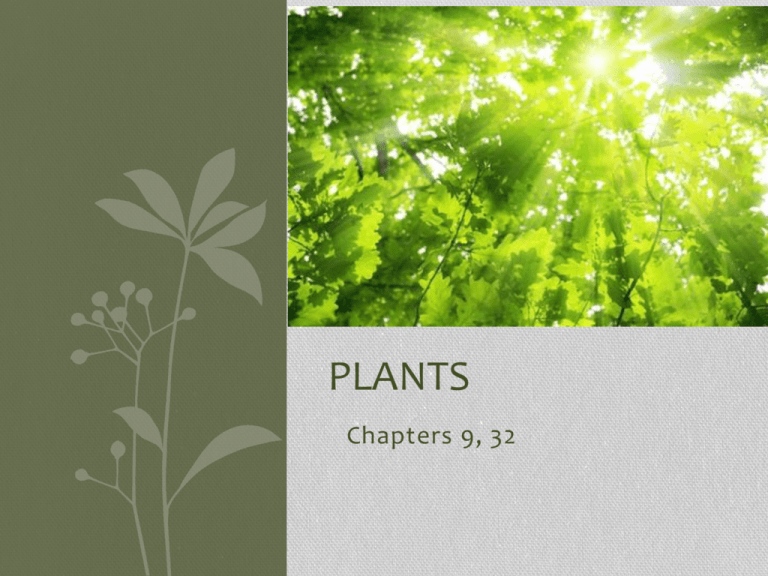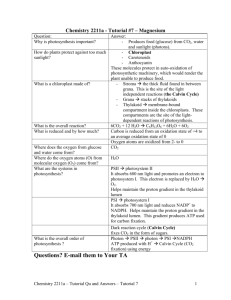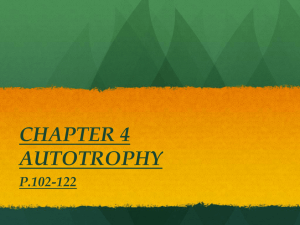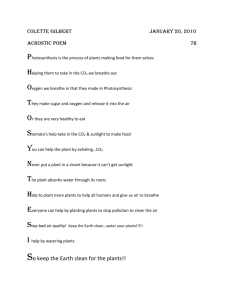PLANTS
advertisement

PLANTS Chapters 9, 32 PHOTOSYNTHESIS: Biological process that captures light energy and transforms it into the chemical energy of organic molecules, which are manufactured from CO2 and H2O PHOTOSYNTHESIS EQUATION: /enzyme • *Very little glucose is stored in plants • Mostly find sucrose • and starches in plants 3Co2 + 3 H20 C3H6O3 + 3 O2 CELLULAR RESPIRATION EQUATION: + enzyme + ATP FYI… • *Very little glucose is stored in plants; Mostly find sucrose and starches in plants Review… Dehydration Synthesis Glycosidic Linkages ? Alpha/Beta Linkages? Starch/cellulose? ? “Flipped chimneys” *H-bonds Ecology-Food Web/Trophic Connection Major Photoautotrophs? Plants, Algae/Phytoplankton, Cyanobacteria (~2.6bya) “The Cycle of Life” Stages of Photosynthesis • STAGE 1: Capturing Light Energy (Light Reactions or Light Dependent Reactions)…on the Thylakoid Membrane • Energy is captured from sunlight (chloroplasts) • Stage 2: Using Light Energy to make ATP and NADPH • ATP = Major Energy Molecule • NADPH = Energy Carrier • Supplies energy needed to drive Stage 3 • Thylakoid Membrane • Stage 3: Calvin Cycle (‘Dark’ Reactions or Light Independent Reactions) • The ATP and NADPH are used to power the manufacture of energy-rich carbohydrates using CO2 from air…..Stroma of the chloroplast Stage 2 • 3 Double–Membrane Organelles? • Chloroplast, Mitochondria, Nucleus Stage 3 *Double Membrane: Chloroplast and Thylakoid STROMA • The innermost membrane of the chloroplast is called the thylakoid membrane. (*double membrane) • The thylakoid membrane is folded upon itself forming many disks called grana (singular = granum). • The "cytoplasm" of the chloroplast is called the stroma Purpose: Convert solar energy to chemical energy Properties of Light p192 • Light: travels as packets of energy (wavelengths) from? • Sunlight: in as UV, out as IR Optical = Visible, what is seen? • Visible Light Absorb vs Reflect: Black? White? Plants: Absorb (ROYBIV) vs reflect (G) Chlorophyll - #1 Pigment-green, Carotenoids- yellow, orange, red Chlorophyll Absorbance Spectrum • • • • Pigments: light harvesting molecules on the thylakoid membranes Each pigment absorbs a different type of light; plant utilizes a much wider range In green plants, the primary photosynthetic pigments are Chlorophylls a & b. *Carotenoids: Deciduous trees, Ripe fruit (Oranges, tomatoes, bananas) Englemann’s Experiment 1883 • Aerobic Bacteria- concentrate near an O2 source Alga Control group? Photosynthesis: Harvesting Light EnergyThe Thylakoid Animation (Notes) Stroma: Outside Thylakoid + + + ADP + P1 4 + + 1 + 3 5 + + NADPH + H NADP+ 2H+ 1 2- (P700) + + + + + + Inside the Thylakoid + + + + + 1. PSII, PSI 2. Reaction Centers: Chlorophyl a (Primary Pigment) 3. Proton Pump 4. ATP Synthase (Carrier Protein, enzyme) 5. Electron Carriers- Membrane Proteins The Light Reactions + + ADP + P1 + + + + NADPH + H + + + + Chemiosmosis 1• Light energy absorbed by all pigments in PSII is funneled down to the reaction center (P680- chlorophyll a); electrons so excited, the pair ‘jump ship’oxidation occurs as e -’s enter the ETC. “Bucket Brigade” *H2O oxidation 2• e-’s power the proton pump- move protons from low (stroma) to high concentration (thylakoid lumen); still enough energy to reach PSI > P700; gives up its e-’s to an electron acceptor…..> stroma; attracted to p + NADPH formed. 3• Need -ATP synthase: ‘tunnel’ for protons to move from high>low (to stroma), and as an enzyme for ADP > ATP ATP + NADPH “Energy on Hold” for Stage 3 Where does the Oxygen come from? 2H2O enzyme ‘Photolysis’: The light splitting of water 4e- + 4p+ + O2 (1 molecule of Oxygen) Two Possible Routes For Electron Flow in LR: Cyclic vs Noncyclic Flow *Notes, Text p200 Primary Acceptor (Reduction) Primary Acceptor (Oxidation) Cyclic vs Noncyclic Noncyclic (Pictured above) Cyclic PSI and PSII (P680 & P700) PSI only (P700) Passes e- from H2O to NADP+ Electrons cycle through the system Generates ATP (chemiosmosis), NADPH and O2 (from H2O) ATP (chemiosmosis) Purpose of Cyclic: Possibly Back Up Plan? Efficiency? ‘Ancient ‘starter’ version? THE CALVIN CYCLE: STEP 3 Light Independent • ‘CYCLE’ RULES: • Need an acceptor molecule (RuBP- 5C molecule the ‘welcoming committee’) and it needs to be replaced RUBISCO • And rubisco enzymecatalyzes the reaction-. **Need 3 molecules of CO2 to make G3P *On a global scale, photosynthesis makes about 160 billion metric tons of carbohydrate per year. No other chemical process on Earth is more productive or is as important to life. PGA- an acid *Produced Stage 2 *Produced Stage 2 PGAL/G3P (G3P) Net Gain of 1 G3P(PGAL) Text p203 Notes p6 Chemiosmosis in Mitochondria and Chloroplasts PHOTOSYNTHESIS vs CELLULAR RESPIRATION *SITE of PHOTOSYNTHESIS > Chloroplasts *SITE of CELLULAR RESPIRATION > Mitochondria* PHOTOSYNTHESIS CELLULAR RESPIRATION Endergonic- energy required to reduce CO2 Exergonic- energy released from oxidation of sugar Light energy source > boosts energy e’s as they move from H2O to sugar e-s from sugar’s hydrogen atoms lose energy as NAD+ transports them to O2 > H2O e-s transferred from H2O > CO2 reducing it to sugar O2 “pulls” e-s down the ETC NADPH receives e-s from ETC NADH delivers e-s to ETC *PHOTOSYNTHESIS is a REDOX REACTION PHOTOSYNTHESIS Photosynthesis 12.27 Light Reactions Calvin Cycle Reactions Occurs in thylakoid membrane Occurs in stroma of chloroplast Powered by light energy Powered by energy from ATP Chlorophyll absorbs light energy in PSI and PSII CO2 taken in from environment H2O taken in from environment Rubisco (Enzyme) catalyzes reaction to incorporate CO2 Light energy splits H2O H2O 2 H+ + 2 e- + ½ O2 (2p+) CO2 + RuBP CO2 Fixation 6-carbon sugar Immediately Oxygen is released into environment 3-C acid 3-C acid Electrons (e-) enter ETS (pump p+ inside thylakoid membrane) ATP from L.R. provides energy ETC powers (chemiosmosis ATP) (p+ diffuse along concentration gradient through ATP synthetase enzyme complex in thylakoid membrane: ADP + Pi ATP) H+ + e- + NADP NADPH NADPH provides H to form sugars PGAL = 1st 3-C sugar *PGAL: 1. replenishes RuBP 2. used to form lipids, proteins 3. Used to form glucose > sucrose > starches Tissue Systems, Tissues and Cell Types • DERMAL: Epidermis, Periderm ‘derm’ • Protection, Stomata Regulation • VASCULAR: Xylem, Phloem • Conduction, support, storage • GROUND: Parenchyma, Sclerenchyma, Collenchyma ‘chyma’ • photosynthesis (*Parenchyma) • Support (Collenchyma, Sclerenchyma) Text p703 Table 32-1 Anatomy of a Plant Leaf • STOMAunderside of leaf (aka stomate, stomata) Mesohyll • GUARD CELLS • MESOPHYLL LAYER: Photosynthetic cells • VASCULAR TISSUE: • XYLEM: Wider Diameter/Water up • PHLOEM: tubes from leaves to the rest of the plant • XYLEM • System of tubes and transport cells that circulate water and dissolved minerals (up from roots) • Support • Dies after one year and then develops new. • Rings of a tree VASCULAR SYSTEMS *Not Circulation • PHLOEM • System of tubes that transports sugars and other molecules created by the plant from photosynthesis • Always alive • The dripping sap from a tree usually phloem PHOTORESPIRATION • The process that reduces the efficiency of photosynthesis in C3 plants during hot spells in summer; requires O2 and produces CO2 and H2O- does NOT produce ATP Evolutionary? (When high CO2 and low O2); GMO’s? • When stomates open, CO2 enters; is available to chloroplasts • When stomates close to conserve water, CO2 exchange is shut off • Chloroplasts still photosynthesizing, leading up to a buildup of O2. • Rubisco enzyme binds to O2 (like it does to CO2) -stops the food making. • Plants go into a dormant-like state. C3 • Anatomically the same (both have Mesophyll cells to store CO2 • Physiologically different- CAM • Most Plants plants keep their • Stomata open during the stomates CLOSED day. • during Photorespirationthe day, slows sugar at production open night. (Rubisco grabs O2 not • Not CO2)as efficient, but • CAM More plants efficientcan in cool/ moist/low survive inlight harsh conditions than C4 or conditions (Desert) CAM (less machinery, less energy required) (Add to Notes P-13) C4 • Corn, Sugarcane, Crabgrass • Stomata open during the day. • Special enzyme for fast uptake of CO2 • Faster photosynthesis than C3 because CO2 then delivered direct to Rubiscostops photorespiration • Can close stomata sooner/ Fast CO2 uptake CAM • Cacti, Orchids, pineapples • Stomata open at night- less transpiration. • Stores CO2 taken in at night as an acid, breaks it down to CO2 as needed. • “CAM-idle” –Dry spell- close stomata night and day- O2 used for respiration, CO2 for photosynthesis • Recover quicker from dry spells than plants that go dormant ROOT FUNCTIONS 1. Anchorage 2. H2O and Mineral Absorption 3. Food Storage 4. Tap Roots vs Fibrous Roots Chapter 35 p748 “TACT” Transpiration Adhesion Cohesion Tension TENSION COHESION MODEL 1.1. • Water vapor transpires from the surface of leaf mesophyll cells to the drier atmosphere through stomata. • This produces a tension that pulls water out of the leaf xylem toward the mesophyll cells 2. • Cohesive forces (water molecules- H bonds)allow columns of water to be pulled up through the xylem Text p741, Figure 34-11 Lab Question #6,7 3. • This in turn pulls water up root xylem, forming continuous column of water from root xylem to stem xylem to leaf xylem. The upward pull of water causes soil water to diffuse into root. Water Potential and Transpiration Translocation in phloem The pressure flow hypothesis In Phloem. Solutes move from sources to sinks • At source cell (leaf), sucrose is actively moved into phloem sieve tubes (*requires ATP)- reducing their water potential…. • Water diffuses in from xylem, raising the osmotic pressure in the sieve tubes, increases turgor pressure • At sink cell (root), sucrose is actively and passively unloaded into the sink cell (*requires ATP) • Water diffuses back into the xylem Text p743, Lab question #4-5 Factors Affecting Rate of Photosynthesis: • Light intensity increases, the rate of photosynthesis increases. • At high light intensities the rate becomes constant, even with further increases in light intensity there are no increases in the rate. • The plant is unable to harvest the light at these high intensities; chlorophyll system can be damaged by very intense light levels. • Why different rates? (Which is C3, C4?) Light Intensity: C3 shade plant vs C3 sun plant vs C4? Factors Affecting Rate of Photosynthesis: • TEMPERATURE: • (a) Increasing rate of photosynthesis as the kinetic energy of reactants increases. • (b) Maximum rate of reaction of photosynthesis at the 'optimal' temperature. • (c) Decrease in rate of photosynthesis as the enzymes become unstable and denature. Factors Affecting Rate of Photosynthesis: CO2 *Very much like the effect of a substrate on the rate of a reaction. (a) O2 is used up- no photosynthesis; only respiring. (b) Concentration of the CO2 (substrate) increases, rate of reaction increases. (c) The atmospheric levels of CO2 and the associated rate photosynthesis. (d) Maximum rate of photosynthesis. (e) There is a range of values for different plants reaching their saturation level with carbon dioxide. Once the saturation level has been reached- no further increase in the rate of photosynthesis Text p581… PLANT KINGDOM Vascular Non-Vascular* • • • • “Bryophytes” No Conducting Tissue Stay Small in Size Ex- Moss, liverworts Seedless* • “Tracheophytes” • Conducting Tissue • Xylem (H2O up) • Phloem (food ‘down’) • Enables Larger Size • Ex: Most Plants Seed Producers • Produce Spores • Ex- Ferns Angiosperms Gymnosperms ALL PLANTS: 1. Eukaryotic 2. Autotrophic 3. Multicellular 4. Chloroplasts 5. Cell Walls Cellulose • Non Flowering “cone-bearing” • “Naked” Seeds (no fruit covering) • Ex- Most Conifers (Evergreenspines/spruce /fir/hemlock/cedar) form/function? • Produce Flowers • Seeds (In Fruits) • Most Abundant Monocots Dicots Parts of a Flower ANGIOSPERMS STAMEN CARPEL (PISTIL) (+ stigma, style) “Perfect Flower” = Having both male and female parts POLLINATION The transfer of pollen from an anther (male) to a stigmas (female) of a flower of the SAME species It is important to remember that the transfer of pollen from the male to the female precedes fertilization SELF POLLINATION CROSS POLLINATION • Pollination involving the same flower, flowers on the same plant, or two genetically identical plants • A reproductive process in which the pollen from one plant is transferred to the stigma of another plant (*Same species) Pollen lands everywhere….what stops fertilization errors?? PREZYGOTIC BARRIERS? Gametic Recognition POLLINATORS? Plant Defenses Adaptions to improve Survival & Reproduction: Mechanical, Chemical *Cuticle- keep water in, pathogens out; close the stomata! Spines! Thorns! *Polymers to reduce digestibility; Odor! *Essential oils- attract predatory insects to kill plant-feeding insects a) Pathogen-associated molecular patterns (PAMP)triggers immunity b-c) Pathogens suppress the immune signaling, while some plants have proteins that resist the suppressor, resulting in an immune response Damage Control – cell death signals • UPON INFECTION, SALICYLIC ACID FORMS A CONCENTRATION GRADIENT WITH HIGHER LEVELS AT THE INFECTION SITE AND LOWER LEVELS OUTWARD- INFECTED CELLS DIE, DISTANT CELLS SURVIVE. Salicylic Acid • AUXIN Hormone- Plant Tipson the ‘dark side’ stimulate the uneven growth • Plant Growth in Response to light/no light • PLANTS RESPOND TO CHANGES IN DAY LENGTH • *Seasonal flowers • Plants use pigments to respond to environmental conditions- day length. Plant Hormones PLANT FERTILIZATION OF FLOWERING PLANTS THE MEGASPORE • ALTERNATION OF GENERATIONS: Dominant independent sporophyte generation; microscopic gametophyte and nutritionally dependent on the sporophyte • DOUBLE FERTILIZATION: Two separate nuclear fusions; unique to flowering plants • HETEROSPOROUS: Two types of spores MEGASPORES: Egg MICROSPORES: Sperm MEGASPOROCYTE: Each young ovule contains a megaspore mother cell produces 4 haploid megaspores (meiosis); one develops into a mature gametophyte- an embryo sac- 7 cellssix with one nuclei, one central cell with two nuclei (polar nuclei). TEXT p610, Fig p612 meiosis 7 cells6- one nuclei 1 with 2 Pollen tube leads to one egg; all but 2 disintegrate Double Fertilization .50 Seed Structure SEEDS: Ovules DICOTS EMBRYO: Epicotyl/plumule: 1st leaves Hypocotyl: Stem Radical: Root ENDOSPERM: Food source MONOCOT FRUITS: Mature, ripened ovaries Two Pathways for solutes and water: SYMPLAST: A continuum consisting of the cytoplasm of many plant cells, connected from one cell to the next by plasmodesmata (cytoplasmic channels) Text p752 APOPLAST: A continuum of the interconnected, porous plant cell walls, along which water moves freely. (around the cell walls) CASPARIAN STRIP: Text p751 Fig 35-4; Lab Packet Endodermal waterproof barrier “the mortar”







